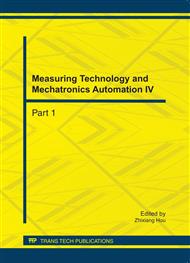[1]
A.D. Waite, Sonar for Practising Engineers, John Wiley & Sons, Ltd, 2002J. Clerk Maxwell, A Treatise on Electricity and Magnetism, 3rd ed., vol. 2. Oxford: Clarendon, 1892, p.68–73.
Google Scholar
[2]
G. Ginolhac and G. Jourdain, Principal component inverse algorithm for detection in the presence of reverberation, " IEEE Journal of Oceanic Engineering, vol. 27, pp.310-320, April 2002K. Elissa, "Title of paper if known, unpublished.
DOI: 10.1109/joe.2002.1002486
Google Scholar
[3]
V. Carmillet, P. O. Amblard, and G. Jourdain, Detection of phase-or frequency-mudulated signals in reverberation noise, Journal of the Acoustic Society of America, vol. 105, No. 6, pp.3375-3389, (1999).
DOI: 10.1121/1.424666
Google Scholar
[4]
Jianlong Li, Xiang Pan, Liming Yan, and Hangfang Zhao, Buried target detection based on time reversal by probing beam, " OCEANS'08 MTS/IEEE Kobe-Techo-Ocean'08-Voyage toward the Future, OTO, 08.
DOI: 10.1109/oceanskobe.2008.4530947
Google Scholar
[5]
Jean-Freancois Cardoso, Blind Signal Separation: statistical principles, Proceedings of the IEEE, vol. 86, pp.2009-2025, October (1998).
Google Scholar
[6]
T. Ristaniemi. Synchronization and Blind Signal Processing in CDMA Systems. PhD thesis, University of Jyväskylä, Jyväskylä, Finland, (2000).
Google Scholar
[7]
S. Makeig, T. -P. Jung, A. J. Bell, D. Ghahramani, and T. Sejnowski. Blind separation of auditory event-related brain responses into independent components. Proc. National Academy of Sciences (USA), 94: 10979–10984, (1997).
DOI: 10.1073/pnas.94.20.10979
Google Scholar
[8]
Cong F Y, Chen C H, and Shi X Z, Blind Separation and reverberation cancelling with active sonar data, Proceeding of The 8th International Symposium on Signal Processing and its Applications, pp: 523-526. (2005).
DOI: 10.1109/isspa.2005.1580990
Google Scholar
[9]
Shi-e Yang. Theory of Underwater sound propagation. Harbin Engineering University Press. 2009, p.123~125.
Google Scholar
[10]
Aapo Hyvärinen, Juha Karhunen, and Erkki Oja, Independent Component Analysis, John Wiley & Sons. Inc, (2001).
Google Scholar
[11]
Yaojie Luo, Qing Zhao, Yanxiang Wu. Statistical Characters of Ocean Reverberation. Science Press. 1977. pp: 126~130.
Google Scholar
[12]
S. Choi and A. Cichocki. Blind separation of nonstationary and temporally correlated sources from noisy mixtures. IEEE Workshop on Neural Networks for Signal Processing, NNSP'2000, pp: 405-414, Sydney, Australia, (2000).
DOI: 10.1109/nnsp.2000.889432
Google Scholar
[13]
S. Choi and A. Cichocki. Blind separation of nonstationary sources in noisy mixtures. Electronics Letters, 36: 848-849, April, (2000).
DOI: 10.1049/el:20000623
Google Scholar


